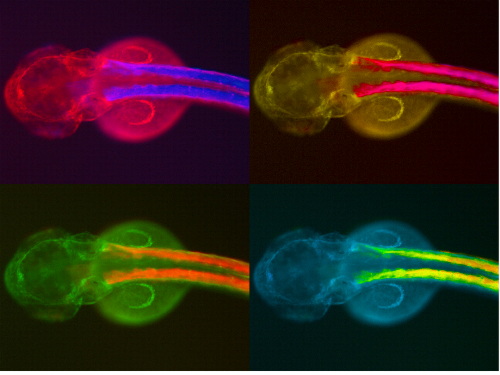

 Less than 5% of vertebrate genomes consist of gene coding sequences.
Moreover, the vast majority of these coding sequences are highly conserved
in all examined species. How did then morphological diversity arise during
evolution? The current genetic theory of morphological evolution states
that "form evolves largely by altering the expression of functionally
conserved proteins and that such changes occur through mutation in the
cis-regulatory sequences of pleiotropic developmental regulatory loci and
of the target genes within the vast networks they control" (Carroll,
2008). Therefore, to a great extent, evolution is the history of changing
the regulation of gene expression during development. Gene regulation is
not only crucial for development, but is also essential for controlling
cell physiology in adult organisms. Therefore, it is not surprising that
many of the large number of genome-wide association studies that have been
reported in the last few years indicate that the lesions associated with
human genetic diseases are usually not in the coding DNA of candidate
genes, but rather in the non-coding regulatory regions associated with
them (Maurano, 2012).
Less than 5% of vertebrate genomes consist of gene coding sequences.
Moreover, the vast majority of these coding sequences are highly conserved
in all examined species. How did then morphological diversity arise during
evolution? The current genetic theory of morphological evolution states
that "form evolves largely by altering the expression of functionally
conserved proteins and that such changes occur through mutation in the
cis-regulatory sequences of pleiotropic developmental regulatory loci and
of the target genes within the vast networks they control" (Carroll,
2008). Therefore, to a great extent, evolution is the history of changing
the regulation of gene expression during development. Gene regulation is
not only crucial for development, but is also essential for controlling
cell physiology in adult organisms. Therefore, it is not surprising that
many of the large number of genome-wide association studies that have been
reported in the last few years indicate that the lesions associated with
human genetic diseases are usually not in the coding DNA of candidate
genes, but rather in the non-coding regulatory regions associated with
them (Maurano, 2012).
In our group we are combining epigenomics, chromosome capture assays, transgenic enhancer experiments and mutagenic studies to determine how cis-regulatory elements and chromatin structure contribute to development and evolution, and how alteration in this non-coding part of the genome affects human health.
Please visit the Research page for more information.
Please visit the Resources page for more information.